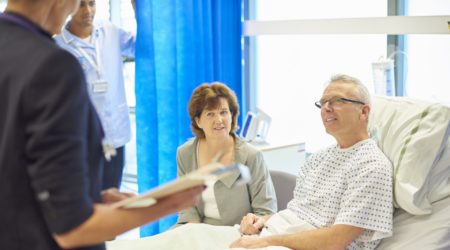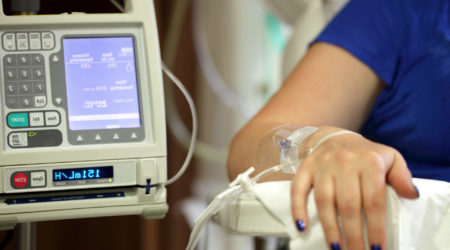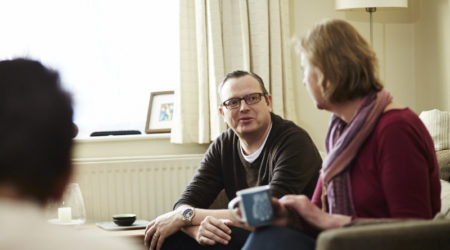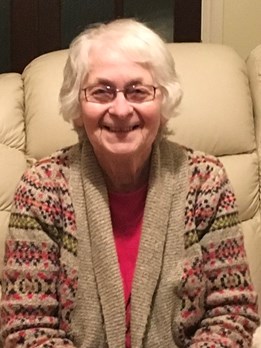

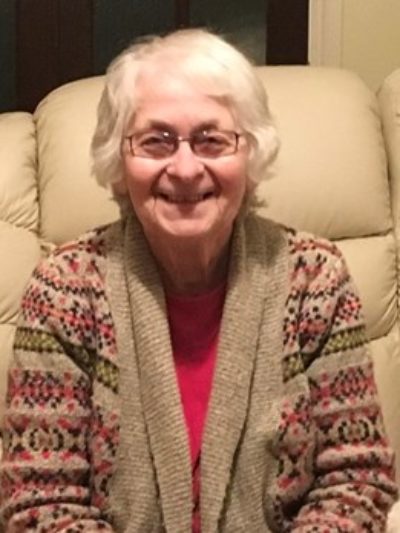

Angela
Angela was diagnosed with stage 3 pancreatic adenocarcinoma in March 2016.
My GP had referred me because several blood tests showed that my amylase levels had remained significantly raised months after my gall bladder was removed. The consultant said there was nothing wrong with me, my amylase level was only mildly raised and there are lots of people walking around with raised amylase. Nothing had shown up on the ultrasound. He had no record of my gallbladder removal earlier in 2014. I now know that raised amylase can indicate something wrong with the pancreas. Further, biopsy of my gall bladder had shown severe inflammation, which can lead to pancreatitis, and pancreatitis in turn can lead to pancreatic cancer.
I thought my loss of appetite and abdominal pains were due to distress
Around the end of August 2015, my cat was seriously ill, so I thought my loss of appetite and abdominal pains were due to distress. However, the symptoms continued for weeks after I had him put to sleep; I could not sit straight because of the pressure and pain just under my ribs, and extreme fatigue had been an issue for some time. Also, I experienced abdominal cramps and pain every time I tried to eat, usually within half an hour, sometimes after several hours. I had to wait a month for an appointment with my GP; by the time I saw her in mid-November 2015, I had lost 10kg.
My GP referred me for an endoscopy
My GP referred me for an endoscopy and review within two weeks. The endoscopy was conducted 1st December 2015, by a nurse who did not record my symptoms accurately, simply writing ‘pain’. Having identified a 5cm hiatus hernia, he advised no further action other than double the dose of Omeprazole which already controlled my acid reflux. After another month waiting to see my GP, she was clear that my symptoms did not reflect those of a hiatus hernia; I was re-referred to the hospital. Doubling the Omeprazole dose did not improve my symptoms; I noticed floating, white stools.
At Christmas 2015, eating only a small amount of food resulted in hours of pain worse than childbirth. I lay doubled-up on my bed all night, and by morning was exhausted. With the benefit of hindsight, I should have called an ambulance, but the media were urging us not to do so. I experienced several such episodes, and told my GP.
I was admitted to hospital
I first saw a consultant on February 29th 2016, by which time I was very weak, had lost several stone, and felt very unwell. I could tolerate only two watery cups of soup a day, and couldn’t even face a cup of tea. This new consultant ordered a blood test and CT scan to be conducted within two weeks.
A CT scan appointment was given for a month later, but within a week, I was admitted to hospital via A&E, yellow down to my lower limbs and with a temperature of 38°C; I was very lethargic. For several days my urine had been dark brown, but my GP had tried to keep me out of hospital, because people were lying on stretchers in A&E corridors. After being told I had a gallstone blocking my bile duct, a CT scan showed pancreatic cancer, extending to my lymph nodes. The ward sister and registrar were very kind when they told me the diagnosis, which they said was inoperable.
Initially I was in shock, my head in a whirl. I had thought I had pancreatitis. My first thought was how I would tell my daughter, who is herself very incapacitated. That night, I decided to focus on the practical, and wrote a long to-do list.
My cancer was operable
A new consultant, specialising in pancreatic cancer, successfully inserted a stent in my bile duct, to relieve the jaundice. He contacted a surgeon to review whether my cancer was operable. After a week, I was sent home to await a decision. After several days, I was so relieved to hear that they thought they could operate that, when I was advised of the odds with and without the Whipple’s procedure, it was a ‘no-brainer’. On 29th March 2016, I had a Whipple’s operation with vein resection, and 8 lymph nodes removed. I spent three days in the HDU, followed by two weeks in the normal ward. When I left, I was still very weak, my wound still leaking.
As I live alone and had no follow-up support, a very kind friend took me to her home for two weeks. Unfortunately, neither of us had fully understood my recuperation needs, and I was admitted to hospital for 4 more nights, having lost 4kg.
I began to recover
I was so happy to get home in early May; seeing the sunshine, birds and flowers in my garden was rejuvenating. After a few days of NHS continuing care, very quickly I began to recover. Generally friends and neighbours have been very kind and supportive. Also, I have had brilliant support from the Rowans hospice companion scheme.
Chemotherapy
About ten weeks after the Whipple’s, I started six months of adjuvant Gemcitabine chemotherapy, with Capecitabine tablets added after the first cycle. A few days after the PICC line was inserted, my arms and hands became swollen and painful; I had a thrombosis along the PICC line, resulting in six months of Clexane injections into my stomach, with associated stinging and bruising.
I missed four chemo treatments out of eighteen, due to low readings of platelets, neutrophils, and haemoglobin. I experienced extreme fatigue, later mediated by dose reductions. I developed bleeding splits in the skin on my fingers and heels, mouth and lip sores, hair thinning (surprisingly, worse after chemo finished). Also, I developed a very large incisional hernia, for which I had an operation on 19th January 2017. In addition, I have ‘dumping syndrome’, an ongoing issue that I’ve not yet learnt to manage. However, after initial trial and error, largely I’m on top of using Creon.
Every day is a bonus!
I have been very lucky to have an excellent and caring surgeon and oncologist consultant. Part-way through chemo, I realised that I was finding the support from the oncology nurses invaluable. It has helped to maintain a sense of humour, to avoid negative thinking and people, to focus on the practical and the now. Every day is a bonus! I have been putting my personal affairs in order. I am planning some time away, although travel insurance is a headache. I am pleased that I have lost over a third of my body weight, clothes look good on me, and I am able to wear clothes from years ago!
I have emphasised the pre-diagnosis period, because, in many ways, these were the worst times, and something might have been done sooner. I feel that the belief that symptoms are ‘too vague’ and that it is ‘too difficult’ is in error, and that with better understanding of the sets of symptoms that many pancreatic patients do suffer, more people could be diagnosed earlier, with better outcomes.
February 2017


